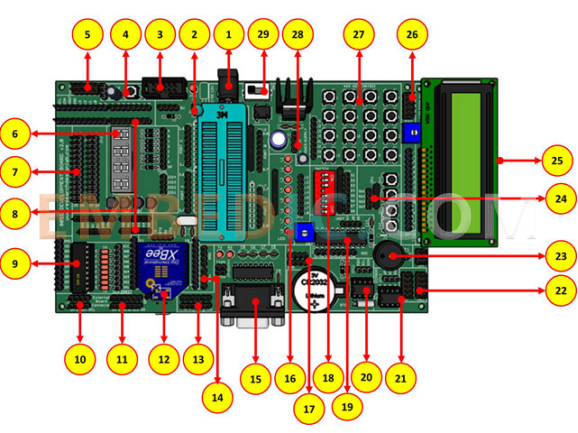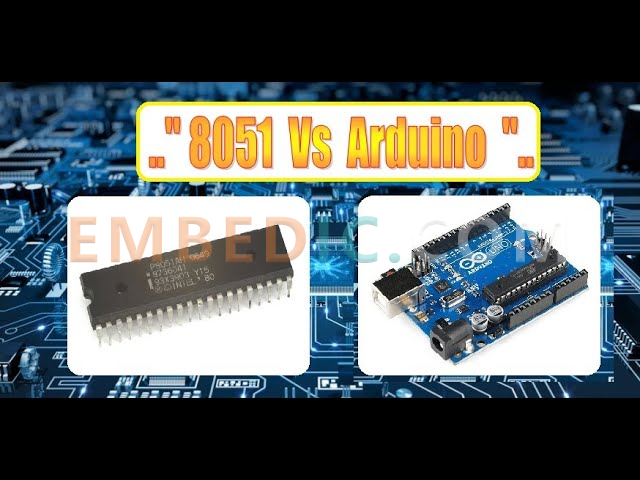In the realm of embedded systems and microcontroller programming, the 8051 development board stands as a cornerstone tool for enthusiasts, hobbyists, and professionals alike. Born out of Intel's groundbreaking microcontroller architecture introduced in 1980, the 8051 has since paved the way for countless innovations in various domains, ranging from home automation to industrial control and beyond.
get started with 8051 development board
At the heart of this ecosystem lies the 8051 development board, a versatile platform that empowers creators to prototype, test, and develop a myriad of projects with ease. Let's embark on a journey to explore the features, applications, and considerations that make the 8051 development board an indispensable asset in the world of embedded systems.
An 8051 Development Board is a versatile platform designed for prototyping and developing projects centered around the 8051 microcontroller architecture.

Originating from Intel's groundbreaking microcontroller design introduced in 1980, the 8051 has since established itself as a cornerstone in the realm of embedded systems. These development boards encapsulate decades of innovation, featuring integrated components such as input/output ports, communication interfaces, and programming connectors. With a rich history spanning over four decades, the 8051 Development Board continues to empower enthusiasts and professionals alike to explore a myriad of applications, ranging from home automation to industrial control, automotive electronics, IoT, and educational projects.
|
No. |
Feature |
Description |
|
1. |
Power Supply |
Supports a range of 5V to 12V input voltage |
|
2. |
ZIF Socket |
40-pin Zero Insertion Force (ZIF) socket for ICs |
|
3. |
ISP Connector |
In-System Programming (ISP) connector |
|
4. |
Reset Button |
Allows resetting the development board |
|
5. |
Node Connector |
Interface for node connection |
|
6. |
7 Segment Display |
Features a 4x1 7-segment LED display |
|
7. |
Raspberry Connector |
26-pin connector compatible with Raspberry Pi |
|
8. |
Arduino Shield Footprint |
Compatible with Arduino shield modules |
|
9. |
ULN 2803 Driver |
Integrated ULN 2803 driver for high-power outputs |
|
10. |
I2C Bus |
Supports I2C communication protocol |
|
11. |
SPI Bus |
Supports SPI communication protocol |
|
12. |
XBEE Footprint |
Compatible with XBEE modules |
|
13. |
FT232 Breakout Board |
Connector for FT232 breakout board |
|
14. |
DC 3.3V Connectors |
Provides connectors for 3.3V power supply |
|
15. |
DB-9 Female Connector |
Features a DB-9 female connector |
|
16. |
LED Array |
Array of 8x1 LEDs for visual feedback |
|
17. |
DC 5V Connectors |
Provides connectors for 5V power supply |
|
18. |
DIP Switch |
8-way DIP switch for configuration |
|
19. |
Analog to Digital Output |
Allows analog input to be converted to digital output |
|
20. |
RTC Module |
Real-Time Clock (RTC) module for timekeeping |
|
21. |
EEPROM |
On-board Electrically Erasable Programmable Read-Only Memory |
|
22. |
Jumper Nodes |
Features 2x5x2 jumper nodes for configuration |
|
23. |
Buzzer |
Includes a buzzer for audio feedback |
|
24. |
Keypad |
Features a 4x1 keypad for input |
|
25. |
LCD Connectors |
Connectors for 16x2 LCD displays |
|
26. |
Node Connector |
Additional node connector for expansion |
|
27. |
Matrix Keypad |
Features a 4x4 matrix keypad for input |
|
28. |
DC 12V Connectors |
Provides connectors for 12V power supply |
|
29. |
Power ON Switch |
Allows turning on/off the power supply |
The versatility of the 8051 development board makes it suitable for a wide range of applications, including but not limited to:
Home Automation: Control and monitor home appliances, lighting systems, and security devices.
Industrial Automation: Implement control systems for manufacturing processes, robotics, and monitoring equipment.
Automotive Electronics: Develop automotive control systems, vehicle diagnostics, and telematics solutions.
IoT (Internet of Things): Create IoT devices for data monitoring, environmental sensing, and remote control applications.
Educational Projects: Ideal for educational institutions and hobbyists, the 8051 development board serves as an excellent platform for learning embedded systems programming and electronics.
There are numerous brands offering 8051 development boards, each with its own unique features and specifications. Some well-known brands include Arduino, Atmel, Texas Instruments, STMicroelectronics, and Cypress Semiconductor. It's essential to research and choose a board that best suits your project requirements and budget.

Arduino is a household name in the world of microcontrollers and development boards, renowned for its user-friendly approach, extensive community support, and versatility. Let's delve into the key features and advantages of Arduino 8051 development boards:
User-Friendly Interface: Arduino boards are designed with beginners in mind, featuring a simple yet powerful integrated development environment (IDE) that allows users to write, compile, and upload code with ease. The IDE supports a wide range of programming languages, including C and C++, making it accessible to both novice and experienced developers.
Extensive Documentation and Community Support: One of the standout features of Arduino is its vast online community, comprised of enthusiasts, hobbyists, and professionals eager to share knowledge, troubleshoot issues, and collaborate on projects. The official Arduino website offers comprehensive documentation, tutorials, and project ideas, empowering users to quickly get started and explore the capabilities of the platform.
Plug-and-Play Compatibility: Arduino boards are known for their plug-and-play compatibility with a myriad of sensors, actuators, and modules available in the market. This seamless integration simplifies the prototyping process, allowing users to focus on designing and implementing their projects without worrying about compatibility issues.
Affordable Pricing: Arduino boards are competitively priced, making them an attractive option for budget-conscious makers and students. Despite their affordability, Arduino boards do not compromise on quality, offering robust performance and reliability.
STMicroelectronics is a global leader in semiconductor manufacturing, offering a wide range of microcontrollers, development boards, and embedded solutions tailored to various applications. Let's explore the unique features and advantages of STMicroelectronics 8051 development boards:
High-Performance Microcontrollers: STMicroelectronics leverages its expertise in semiconductor technology to deliver high-performance microcontrollers with advanced features and capabilities. Their 8051 development boards are powered by state-of-the-art MCUs, offering enhanced processing power, memory, and peripherals for demanding applications.
Rich Peripheral Integration: STMicroelectronics 8051 development boards boast a rich array of integrated peripherals, including analog-to-digital converters (ADCs), digital-to-analog converters (DACs), timers, and communication interfaces. This comprehensive feature set enables developers to implement a wide range of functionality without the need for external components.
Hardware and Software Integration: STMicroelectronics offers a seamless integration of hardware and software development tools, providing developers with a cohesive ecosystem for prototyping, debugging, and deploying their projects. The company's proprietary software development environment, coupled with extensive libraries and middleware, streamlines the development process and accelerates time to market.
Industrial-Grade Reliability: STMicroelectronics is renowned for its commitment to quality and reliability, catering to the stringent requirements of industrial and automotive applications. Their 8051 development boards undergo rigorous testing and validation processes to ensure optimal performance and long-term reliability in harsh environments.
Comparison:
Arduino excels in user-friendliness and community support, making it an ideal choice for beginners and hobbyists who prioritize ease of use and access to resources.
STMicroelectronics shines in terms of performance, integration, and reliability, catering to professionals and developers working on complex projects with demanding requirements.
Choosing a suitable 8051 development board requires careful consideration of your project requirements, budget, and level of expertise. Here are key factors to consider,
|
Factor |
Description |
|
Microcontroller |
Evaluate the microcontroller model and specifications (CPU speed, memory, peripherals). |
|
Development Tools |
Assess the availability and usability of development tools (IDE, compilers, debuggers). |
|
Input/Output Options |
Consider the availability and types of input/output ports (digital, analog, communication interfaces). |
|
Expansion Capabilities |
Look for expansion headers/slots for adding additional modules or sensors. |
|
Power Supply |
Check the power supply options (USB, external power source) and voltage compatibility. |
|
Compatibility |
Ensure compatibility with programming languages, operating systems, and development environments. |
|
Documentation |
Evaluate the quality and comprehensiveness of documentation, tutorials, and support resources. |
|
Community Support |
Assess the availability of online forums, communities, and user groups for troubleshooting and knowledge sharing. |
|
Cost |
Consider the overall cost of the development board, including additional accessories and shipping expenses. |
In conclusion, the 8051 development board serves as a versatile and powerful tool for exploring the world of embedded systems and microcontroller programming. With its comprehensive features, wide range of applications, and support from various brands, it remains a popular choice among enthusiasts and professionals alike. Whether you're a beginner looking to learn the basics of electronics or an experienced developer working on advanced projects, the 8051 development board offers endless possibilities for innovation and creativity.
Further Reading:
[2022] The Ultimate Guide about 8051 Microcontroller
The Difference Between Arduino and 8051 Microcontroller
The Timers and Counters in 8051 Microcontroller 2023
8051 Microcontroller Block Diagram and Pinout
Manufacturer: Texas Instruments
IC DSP FIXED-POINT 532FCBGA
Product Categories: DSP
Lifecycle:
RoHS:
Manufacturer: Analog Devices
IC DSP BLACKFIN 400MHZ 400CSBGA
Product Categories: DSP
Lifecycle:
RoHS:
Manufacturer: Texas Instruments
IC DSP FIX/FLOAT POINT 256BGA
Product Categories: DSP
Lifecycle:
RoHS:
Manufacturer: Texas Instruments
IC DGTL MEDIA PROCESSR 684FCBGA
Product Categories: DSP
Lifecycle:
RoHS:
Looking forward to your comment
Comment